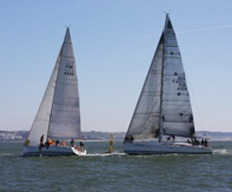
Cruiser racing: clear crew roles
Clear crew role(s) will help you put in a slick race performance
Crew Roles
In an ideal world you’d have a full complement of crew each with a specific role during a race. This allows the helm to concentrate on helming, the tactician to tactic and the trimmers to do their stuff. In real life you are often racing short-handed and everyone has to fulfill more than one role. Let’s have a look at the common roles onboard.
Common Roles

1.) BOW - Looks after the front of the boat and is in charge of hoisting/lowering the headsail and spinnaker making sure all halyards and sheets are led properly and not twisted. During a gybe they are responsible for releasing the old spinnaker sheets and attaching the new. They often work together with MAST.
2.) MAST - Backs up the BOW by helping with the front of the boat. ‘Sweats’ the halyards at the mast to aid speedy hoisting of sails and is responsible for raising the mast end of the spinnaker pole during hoists and gybes. On smaller boats with end for end pole systems, there is no need for MAST as the pole can be handled solely by BOW during a gybe.
3.) PIT - Looks after the cockpit end of all the halyards, kicking strap, up hauls, down hauls and adjusts the spinnaker pole height. PIT is in control of raising and lowering all sails and makes sure the halyard ends are kept tidy to ensure they will run freely when required.
4 & 5) COCKPIT TEAM - Usually two people working together controlling sail setting. Upwind; trimming the jib for correct position, releasing the old sheet during a tack and quickly pulling in the new sheet. Downwind; playing the spinnaker sheet for correct position, one on sheet and the other ready to winch if required, trimming the guy to adjust the pole position in association with PIT who will need to adjust the pole up haul/down haul accordingly.
6) MAINSHEET - Trims the main.
7) HELM - Steers the boat, hopefully in the right direction and as fast as possible.
8) TACTICIAN - Gathers information for the race such as weather, tides and course. Makes the decisions about where to go, when to tack and gybe based on the wind, tide, course and other boats. Communicates with the rest of the crew about what is happening, allowing them to do their jobs when required.
9) OWNER - Pays the bills and takes the glory…

Sailing downwind, crew move back nearer the cockpit but not obstructing the COCKPIT TEAM from trimming the spinnaker.
On larger boats if there are more people, it may be possible to have an extra person to help the COCKPIT TEAM, to act as a floater helping wherever a need arises or just as extra weight on the rail. Some class rules have a crew number limit such as the Sigma 33 class which restricts the crew size to a maximum of 7.
Tacking round a mark, the crew of POR 4500 complete their tack and are getting back to sitting on the rail to keep the boat flat. POR 4508 is mid tack, the COCKPIT TEAM are busy getting the jib across, BOW is making sure the jib crosses over and is inside the guard wires. Two more crew can be seen behind the main getting ready to cross sides under the boom & keep out of the way.
Large boats are raced around the world and around courses single or double handed, so it comes down to thinking ahead and technique. On a normally under-crewed yacht, the tactician could also be MAINSHEET or one of the COCKPIT TEAM. The PIT role could also be performed by one of the COCKPIT TEAM.
However the roles are allocated on your boat, it is essential that each person understands what their role is and what they are expected to do. If possible have a practice run so everyone can get to grips with their role without the stress of having to do it quickly during a race.
Words & pictures: Simon Jinks, RYA Instructor and Examiner and Vicky Jinks
Contact UsArticle Published: October 22, 2012 12:44